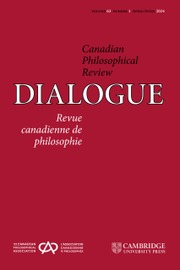No CrossRef data available.
Article contents
Negative Entities: Modes of Being or Degrees of Being?
Published online by Cambridge University Press: 04 September 2025
Abstract
Negative entities such as holes, cavities, and shadows are metaphysically puzzling. Despite evidence supporting their existence, their nature as absences of positive entities raises questions about their ontological status. How can negative beings exist while differing fundamentally from positive entities? To address this issue, Kris McDaniel’s ontological pluralism offers a solution by granting negative entities “being by courtesy.” This article reviews McDaniel’s proposal, presents a challenge to it, and offers an alternative solution within the framework of ontological pluralism. The conclusion addresses an objection and provides a response, contributing to the ongoing debate about the metaphysical reality of negative entities.
Résumé
Les entités négatives telles que les trous, les cavités et les ombres posent des énigmes métaphysiques. Bien que leur existence soit soutenue par des preuves, leur nature en tant qu’absences d’entités positives soulève des questions quant à leur statut ontologique. Comment des êtres négatifs peuvent-ils exister tout en différant fondamentalement des entités positives ? Pour aborder cette problématique, le pluralisme ontologique de Kris McDaniel propose une solution en accordant aux entités négatives un « être par courtoisie ». Cet article examine la proposition de McDaniel, en présente une critique, et propose une solution alternative dans le cadre du pluralisme ontologique. La conclusion répond à une objection et offre une réponse, contribuant ainsi au débat en cours sur la réalité métaphysique des entités négatives.
Information
- Type
- Article
- Information
- Copyright
- © The Author(s), 2025. Published by Cambridge University Press on behalf of the Canadian Philosophical Association/Publié par Cambridge University Press au nom de l’Association canadienne de philosophie


